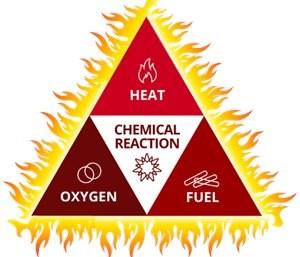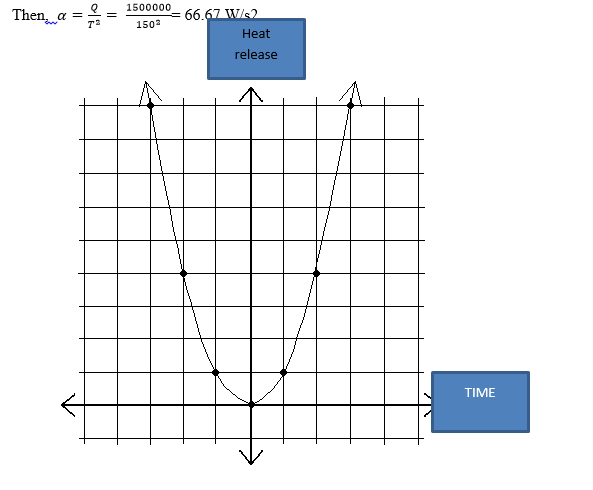Fire Technology & Engineering Principles Assignment Help
Never be caught in plagiarism, Avail Fire Technology & Engineering Principles Assignment Help solution service of Expertsminds.com and save higher marks!
Describe the “fire triangle” and discuss the importance of each element in the combustion process
Answer
A simplified relative to the hearth polyhedron, the hearth triangle may be a model for conveyance the elements of a fireplace. the hearth triangle’s 3 sides illustrate the 3components of fireside, that area unit heat, fuel and oxidisation.
The 3 components should be combined within the right proportions for a fireplace to occur. If any of the 3 components area unit removed, the hearth is destroyed.
the hearth triangle’s 3 sides represent heat, fuel and oxidisation.
The fire triangle’s 3 sides represent heat, fuel and oxidisation.

The first part within the fireplace triangle is heat, that is maybe the foremost essential of fireside components. a fireplace cannot ignite unless it's a particular quantity of warmth, and it cannot grow while not heat either.One of the primary things firefighters do to extinguish a fireplace is to use a cooling agent – typically water. Another cooling agent may be a chemical fireplace retardent, like those employed in fireplace extinguishers.Another methodology of dispersive heat from a fireplace is to scrape the embers from the hearth supply, like wood embers on a burning building. Firefighters also will shut down the electricity in an exceedingly burning building to get rid of a supply of warmth.
The second part within the fireplace triangle is fuel. a fireplace desires a fuel supply so as to burn. The fuel supply will be something that's combustible, like wood, paper, fabric, or chemicals. Once the fuel part of the hearth triangle is removed, the hearth canwithdraw.
If a fireplace is allowed to burn with none decide to extinguish it, as within the case of a controlled burn conducted by the Forest Service, it'll extinguish on its own once it'sconsumed all of the fuel.
The final part of the hearth triangle is atomic number 8, that is additionally a necessarypart of fireside. a fireplace desires atomic number 8 to begin and continue. that's why one recommendation for extinction alittle fireplace is to smother it with a non-flammable blanket, sand or dirt.
2.In your own words explain what “Activation Energy” is. If two polymers had different activation energies, which one would be easier to ignite? Explain
Answer:
The term activation energy represents the energy required for occurring a reaction. It may be high for some molecules and may be low for some molecules depending on their chemical nature and chemical properties. A polymer having higher value of activation energy will take higher amount if activation energy and the polymer having low activation energy will ignite easily at a very low amount of energy. So , the polymer having lower value of activation energy will ignite earlier than that of polymer having higher activation energy.
3. If the Heat of Combustion of Benzene (C6H6) is 4.25MJ per mole; How much heat can I expect to be released if I burn 100g of Benzene knowing that the Combustion Efficiency is only 80%. Show your workings.
Answer:
Moles is given by
Here M = 78.11 g/ mol
m = 100 grams
then, moles n= 100/78.11= 1.28 moles
then energy released will be E = 1.28(0.8)(4.25 MJ)
E= 4.352 MJ.
4.In your own words explain what is the relevance of the “Thermal Diffusivity” of a brick to the temperature measured on the hot side of a brick wall heated on one side.
Answer:
By definition “the thermal physical phenomenon of a substance divided by the merchandise of its density and its heat energy capacity” .In straightforward word diffusivity signifies penetration .Thermal diffusivity means that, How fast or however simply heat will penetrate a object/substance. (Same construct is employed in fluid dynamics referred to as as momentum diffusivity or kinematic viscosity).Higher the diffusivity, bigger the penetration. An object with higher physical phenomenon and tenuity and low Cp (specific heat or heat capacity) offers easy penetration of warmth therefore it's the next thermal diffusivity. Low heat capability signifies ‘amount of warmth needed to extend the temperature of a substance is low’.
We can calculate the value of thermal diffusivity by the relation as follows.
Where k =thermal conductivity
5 Calculate the conductive heat transfer rate through a concrete slab of 250 mm thickness where the bottom is exposed to a temperature of 600 oC and the top is at ambient conditions. (1 Mark) where ambient temperature is 20 oC
Answer:
The heat transfer amount can be concluded as
For concrete K = 0.8
A= 1 m2
dT = 600-20 = 580
dx = 250 mm = 0.25 m
then,
Q=1856
6. If a “Black-body Radiator” was at a temperature of 950oC, how much radiant heat energy would it be emitting over every square metre of surface area?
Answer:
The black body emission energy is given as
Where
T = 950+273 = 1223 K
Then,
E= 33558.07 W
7. A steel plate is exposed to a fire-source-feature on a neighbouring property and receives a radiant heat flux of 65 kW/m2. Assuming the steel plate has an emissivity of 0.8, what temperature would the plate heat up to?
Answer:
Heat flux is given by
E = 65000 W.
Then,
T = 1094.10 K .
8.
Hot gases at 600oC from a fire are flowing past a plasterboard wall whose exposed surface has already been heated to 200oC. How much convective heat energy is transferred from the hot gases to the wall per square metre if the heat transfer coefficient is 15W/K m2
Answer:
Convective heat transfer is given as
Here h=15W/K m2
dT = 400
A =1
then,
Q= 6000 W = 6 kW.
9.
From the question above, if the effective emissivity of the hot gases is 0.8 and the emissivity of the plasterboard wall is 0.9 in the above question, how much net radiant energy is transferred per square metre to the wall?
Answer:
The emissive power is given by
Where
A = 1 m2
Then,
Equivalent emissivity = 0.735
E= 22120.23 W = 22.12 KW.
10.
A room with a flashover fire has a window 1.8 m high and 2.4 m wide which is emitting radiant heat at a mean value of 149 kW/m2. What is the maximum radant heat flux that would be received at the property boundary 1 m away assuming that the window is a black-body?
Answer:
The maximum radiant heat flux is given by:
If window is black body then, the emissivity will be 1.
AREA A= 1.8*2.4 = 4.32 m2
Heat flux = E= 149 kW/m2= 149000 W/m2
11.
A fire is burning near the corner of a 5mx5m room having a ceiling height of 3.0m. The fire is ventilated through an open doorway where hot gasesflow out of the room and cold air flows into the room. There is an upholstered lounge suite in the middle of the room that can be assumed to ignite in a relatively short period of time when exposed to a radiant heat flux of 18kW/m2. What temperature would the hot gases beneath the ceiling need to be for the lounge suite to ignite? Assume that the hot layer has an emissivity of 1 and that the hot layer is 1.2m above the top of the lounge suite.
Answer:
Radiant energy is given by
A = area = 5*1.2 = 6 m2
T = 479.6 K
(b) Compare your answer with the following statements:
a. “A temperature between 400 and 600oC of the hot layer gases is likely to result in flashover in a compartment.”
b. “Flashover is likely to occur when the tip of the flames reach the ceiling”.
Answer: For part A if we find the mean temperature for that condition then
Mean temperature = T= (400+600)/2 = 500
So this condition will generate higher amount of heat as compared to the conditions in previous question. This condition will be harmful.
For part B if the flames reach to the ceiling the, it would be the severe condition of fire burning and will cause a higher amount of heat be emitted and can cause higher amount of causality as compared to the previous conditions.
12
a) Plot the heat release rate of a fire that has the following characteristics:
i. Initial growth as a t2 fire at a rate that achieves a convective heat output of 1.5 MW after 150 seconds until sprinkler activation.
ii. Sprinklers activate when the total heat release rate of the fire has grown to 3 MW.
iii. The sprinkler system has been designed to an “Ordinary Hazard” occupancy with a discharge density of 0.08 mm/s. Following sprinkler activation the heat release rate of the fire follows the “NIST” equation fore sprinkler suppression.
Answer:
1) we can calculate the value of constant alpha used in equation as
T = time

Here Y = heat release
X = time
2)
3000000=(66.67) T^2
T= 212.12 sec.
3)for NIST equation is given by
H=0.73 .e^(-0.00225 t)
0.08 = 0.73 .e^(-0.00225 t)
t = 982.67 s
(b) Discuss the following with respect to a sprinkler system:
i. Required Delivered Density
ii. Actual Delivered Density
iii. Fire control
iv. Fire suppression
Required delivered density:-
The required delivered density is density required for escaping hazards and stop causality done by fire. A fire sprinkler required delivered density is the hypothetical density determined by the formulas and calculation.
Actual delivered density :-
The Actual Delivered Density (ADD) is calculated supported the individual water
collection rate measurements. The ADD is outlined because the average water density (flux)
over the world of the complete twenty water-collection pans; the world coated by these pans
corresponds to the highest surface of the ignition array, together with flue areas, in an exceedingly large-scale rack storage hearth check.
Fire control:-
Fire control is basically the controlling of the fire causalities and the spreading of fire at various sections. Fire control is mainly done with the help of the extinguisher, sprinklers. In this step the sprinkler supplied the enough amount of cooling or water in order to stop fire spreading.
Suppression system:-
Fire suppression system is nothing but the another form of fire controlling but it include different types of fire control planning based on various conditions such as environmental conditions, physical conditions. There are various type of fir suppression sytems present in current time.
Expertsminds.com gives accountability of your time and Money – Avail TOP results originated Fire Technology & Engineering Principles Assignment Help solution services at best rates!